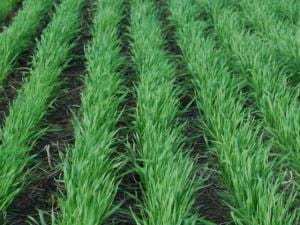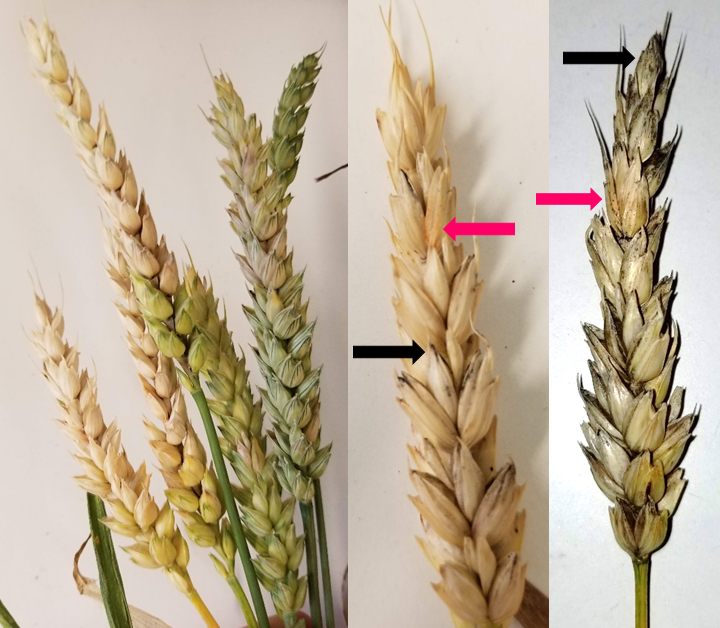Click here to download an excel copy of the 2021 Ohio Wheat Performance Test. Disease information will be added as it becomes available.
The purpose of the Ohio Wheat Performance Test is to evaluate wheat varieties, blends, brands, and breeding lines for yield, grain quality, and other important performance characteristics. This information gives wheat producers comparative information for selecting the varieties best suited for their production system and market. Varieties differ in yield potential, winter hardiness, maturity, standability, disease and insect resistance, and other agronomic characteristics. Selection should be based on performance from multiple test sites and years.
EVALUATION PROCEDURES
Each entry was evaluated at five test sites using four replications per site in a randomized complete block design. Plots consisted of 7 rows, 7.5 inches apart and 25 feet long. Participating companies specified the seeding rate used for each of their varieties. Test sites were planted within twenty-one days after the fly-free date based on soil conditions. Approximately 30 pounds of nitrogen/acre was applied at planting followed by the addition of 80-100 pounds/acre in early spring. Herbicides, insecticides, and fungicides were applied as needed. The following data were collected:
Yield is reported in bushels/acre at 13.5 percent moisture.
Test Weight is reported in lb/bushel averaged across all locations.
Seed Size is thousands of harvested seeds per pound (Ex: 15.5 = 15,500 seeds/lb).
Lodging is the percent of plants that lean more than 45 degrees from vertical.
Plant Height is the distance in inches from the soil surface to the top of the heads.
Heading Date was the average calendar day of the year on which 50 percent of the heads were completely emerged. Average of Wood and Pickaway locations. (Example: Day 135 = May 15)
Powdery mildew (PM) Varieties were evaluated for Powdery mildew at Wooster at the heading (Feekes growth stage 10.5) growth stage. Varieties were classified as Susceptible, Moderately Susceptible, Moderately Resistant, and Resistant.
Fusarium Head Blight (FHB) Varieties were evaluated in an inoculated disease screening nursery at Wooster. FHB was rated as the percentage of spikelets showing diseased symptoms. Varieties were classified as Susceptible, Moderately Susceptible, Moderately Resistant, and Resistant.
Leaf Blotch (SLB) and Glume Blotch (SGB) Varieties were evaluated for Stagonospora leaf and glume blotch in an inoculated, mist-irrigated disease screening nursery at Wooster. Both SLB and SGB severity were rated at about Feekes growth stage 11.3 as the average percent flag leaf and spike area diseased, respectively. Varieties were classified as Susceptible, Moderately Susceptible, Moderately Resistant, and Resistant.
Flour Yield is the percent flour yield from milled whole grain.
Flour Softness is the percent of fine-granular milled flour. Values higher than approximately 50 indicate kernel textures that are appropriate for soft wheat. Generally, high values are more desirable.
CULTURAL PRACTICES BY TEST SITE
| 1 | 2 | 3 | 4 | 5 | |
| County | Wood | Madison | Wayne | Darke | Pickaway |
| Previous Crop | Soybean | Soybean | Soybean | Soybean | Soybean |
| Soil Type | Hoytville | Crosby | Canfield | Crosby | Miamian |
| Tillage | Min-Till | No-Till | Min-Till | Min-Till | Min-Till |
| Fly-Free Date | Sept. 23 | Sept. 30 | Sept. 26 | Sept. 29 | Oct. 1 |
| Plant Date | Sept. 25 | Sept. 27 | Oct. 3 | Sept. 26 | Oct. 9 |
| Soil pH | 6.6 | 6.7 | 6.0 | 6.5 | 5.7 |
| Soil P (ppm) | 47 | 25 | 51 | 91 | 37 |
| Soil K (ppm) | 214 | 143 | 238 | 220 | 127 |
| Fertilizer (N, P, K) | 120-78-78 | 177-78-0-43S | 119-46-120 | 120-2-78-30S | 118-66-60-10S |
| Herbicides | Quelex | Roundup, Sharpen (Pre-Plant); Harmony Extra SG, Brox 2EC (Spring) | Sharpen (Pre-Plant); Harmony Extra SG (Spring) | Harmony Extra SG, Brox 2EC | Quelex |
| Fungicide | Prosaro | Tilt (Feekes 6); Miravis Ace | Prosaro | Miravis Ace | Miravis Ace |
| Insecticide | None | None | Lamcap II | None | Lamcap II |
| Harvest Date | July 5 | July 6 | July 6 | July 6 | June 29 |
GROWING CONDITIONS
In fall 2020, wheat was planted at all five locations within 8 days of the fly-free date. Wheat entered dormancy in good to excellent condition. Cool temperatures and adequate moisture lead to a long grain fill period and high-yielding conditions. Harvest conditions were favorable and harvest dates average. Overall, grain test weight averaged 58.1 lb/bu (compared to an average test weight of 58.8 lb/bu in 2020). Grain yield averaged between 85.1 and 115.0 bu/acre among the five locations
RESULTS
Results of the 2021 wheat performance test are presented in Tables 1-3. Entries in the data tables are arranged by seed source. A least significant difference (LSD) value can be used to determine if the performance of two varieties was statistically different. The yields of two varieties are expected to be significantly different 90 percent of the time if their yields differ by more than the reported LSD value. Flour yield and softness tests were performed by USDA-ARS Soft Wheat Quality Laboratory, at OARDC in Wooster, OH, Dr. Byung-Kee Baik, Director.
Test results for the 79 winter wheat varieties evaluated in 2021 are presented in Table 1. Tables 2 and 3 contain multi-year variety performance data. Depending on variety and test site, yields varied between 74.7 and 128.2 bushels per acre and test weight ranged from 55.1 to 60.3 pounds per bushel. Yield differences between test sites were due primarily to the soil drainage, weather during the grain fill period & harvest, and disease level. Variety selection should be based on disease resistance, average yield across test sites and years (Tables 2 & 3), winter hardiness, test weight and standability.
Inclusion of varieties in the Ohio Wheat Performance Test does not constitute an endorsement of any variety by The Ohio State University, Ohio Agriculture Research and Development Center, or Ohio State University Extension.
Authors: M.W. Hankinson, J.S. McCormick, A.B. Geyer, C.H. Sneller, L.E. Lindsey, P. Paul, Dept. of Plant Pathology, D.G. Lohnes
Acknowledgments: We thank our farmer cooperators for their contributions to the 2021 wheat variety testing program. We are grateful for the assistance provided by Ken Scaife, OARDC Field Operations, Wooster and Matt Davis, OARDC Northwest Branch Research Station. We thank CFAES Marketing and Communications for their assistance in preparing the test results for publication. Special thanks to Rich Minyo, OARDC Wooster, for his assistance and expertise in conducting the 2021 Ohio Wheat Performance Test.


